Tags
Last Updated: 2025-05-27
Purpose
This article provides an overview of the Tagging feature.
Introduction
The tagging feature is an essential tool for keeping infrastructure organized and manageable. Tags is a user-defined way to categorize, filter, and handle data across a variety of entities such as assets, configurations, and findings. By applying tags to objects, custom filtering options can be implemented that help manage large datasets. Tags can be inherited by related resources, creating a hierarchical structure that ensures consistency and saves time. This allows you to group and filter through data, thus making tags a practical tool for maintaining order in complex infrastructures. Tags are also useful when limiting the access for users, granting them visuals and access to assets, configurations, and data for the respective tag that are associated accordingly.
Key and Value
When creating a new tag, it is required to give the tag a Key word which then can be provided with an optional Value.
The provided key word will be the word to search for when filtering for specific tags, and the value provides an option of specifying a value, enabling multiple tags with the same Key but different Values.
Key | Value |
|---|---|
WindowsServer | Internal |
WindowsServer | External |
This enables you to search for all assets and findings for example, with the tag WindowsServer to get both Internal and External, or specify the value with a colon ( : ) character WindowsServer:Internal to show the Internal only.
You can create a new tag directly in this window with one of the following input formats Key:value or Key word only – Press “create new tag” and “Submit” to add it on the Asset.
Tagging and Filtering
Filters allow for quick limitation of viewed data to relevant entries. By applying filters in multiple columns, it is possible to narrow down a large dataset to find a particular entry or to discover any abnormalities, missing data, or missing actions. Tagging helps to create more custom filtering options by adding specific tags to various entities. Customize each view by adding or removing the tags and by applying filters.
Each view has Column, Filter and View Template panels accessible in the top left corner of the view.
Clicking the column
 icon displays the column panel, where columns can be enabled or disabled from the view.
icon displays the column panel, where columns can be enabled or disabled from the view.Clicking the filter
 icon displays the filter panel, where filters can be applied to the columns.
icon displays the filter panel, where filters can be applied to the columns. Clicking the view templates
 icon displays saved view templates.
icon displays saved view templates.
The current view state can be saved and made to persist on your account.
Requirement
It is assumed that the reader has basic access to the OUTSCAN/HIAB account to access the Portal.
User need to be assigned to a role with Tags set to Manage to be able to manage tags. See Identity and Access Management (IAM) for more information on how to set roles.
Tags
Tagging allows to group and filter data based on a user-defined value. Tags can be added in:
Assets
Asset Groups
Configurations
Findings
Compliance findings
Accounts
Adding a Tag to an Object
Add tags by right-clicking on the object and click the Edit tags icon in the context menu.

The Edit tags form is displayed.

Enter a tag name in the Search tags row. Available tags matching the search criteria is listed.

Select one of the available tags, or click the CREATE NEW TAG button to create a new tag.
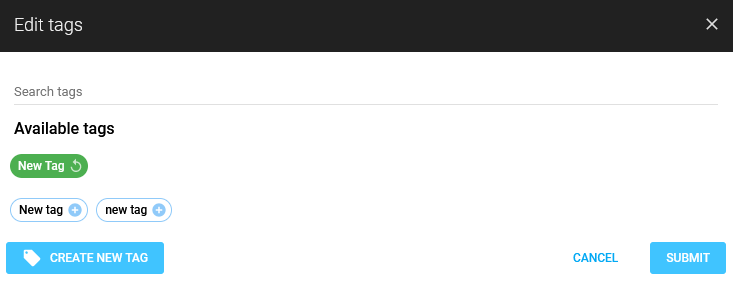
Click the SUBMIT button to save the new tag and attach it to the object.
The colon character ":", splits the content of the tag into a key and a value. Thus allowing a granular search for the occurrences of tags containing the search word in the key or in the value. Tags that do not contain a colon are handled as keys.
Input format: Key:value or just Key
Example:
When the added tags are:
aws:yes
hosting:aws
aws
Searching for aws results in all 3 entries.
Whereas, searching for aws: results in tags with aws string as the key.
To find the values containing the phrase, prefix it with colon. Searching for :aws results hosting:aws only.
Examples of a valid tag format:
Location:London
digital-media
NetworkAlpha
Edit a Tag on an Object
Editing a is the same as adding a Tag.
Edit tags by right-clicking on the object and click the Edit tags icon in the context menu.

Follow the same steps as in Adding a tag to a object.
Tags that are displayed in grey cannot be edited since they are inherited. See Tag Inheritance.
Removing Tags from Object
Click on the X directly on the tag in the row to remove it from that object.

Or
Right click on a object and select Edit Tags in the context menu.

Click on the X on the displayed tag.
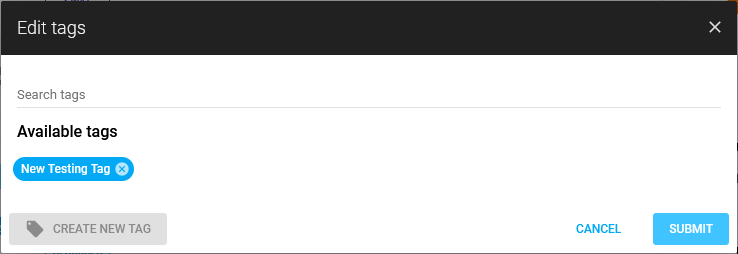
A new dialog is displayed with the tag marked in red.

Click SUBMIT to remove the tag from the object.
Tag Inheritance
Some resources inherit tags from their parent resources. This is true for the following resources:
Scans (inherited from Configurations)
Matches (inherited from AssetGroups and Assets)
Services (inherited from AssetGroups and Assets)
Credentials (inherited from Accounts)
Findings (inherited from AssetGroups and Assets)
Compliance findings (inherited from AssetGroups and Assets)
An example:
Setting a location:sydney tag on the gcp-account-180821 resource will populate the same tag on all compliance findings associated with this resource:


The inherited tags will appear as greyed out:

These tags cannot be removed from the resource unless they are removed from the parent resource.
Tag Manager
The Tag Manager lets you view, understand, and manage the tags that are used on objects of different types on your account.
You are able to see what tags, keys that exists as well as what object types and the number of occurrences.
Column | Description |
|---|---|
Created | When the tag was created. |
Created by | Who created the tag. |
ID | The unique identification number of the tag. |
Key | The name of the tag. |
Statistics | Number of occurrences. |
Updated | When the tag was updated. |
Updated by | Who updated the tag. |
To open the tag manager, click Tags in the main menu on the left hand side.
Statistics
The Statistics view shows how many objects a tag is used on.
The example show that 5 assets and 1 asset identifier share this tag.
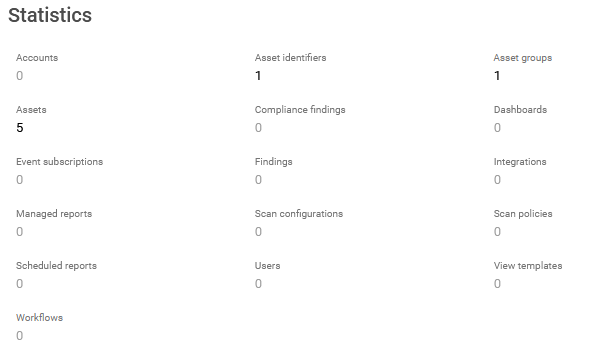
Settings
Resource group settings
Scan configuration settings
Scheduled report settings
Create New Tag
To create a new tag in the tag manager:
Click the green plus
 icon in the lower right corner.
icon in the lower right corner.Select Create new tag.
Enter a Key name or select one from the drop-down menu.
(Value?)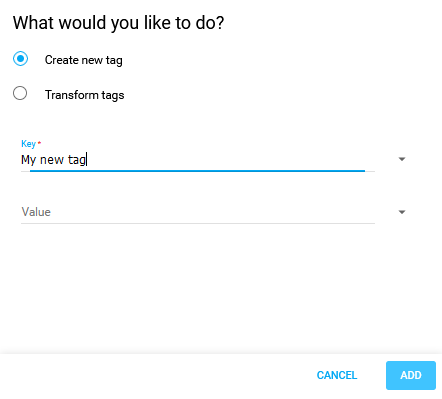
Click the blue ADD button to save the new tag.
Transform a Tag
To transform a tag in the tag manager:
Click the green plus
 icon in the lower right corner.
icon in the lower right corner.Select Transform tags.
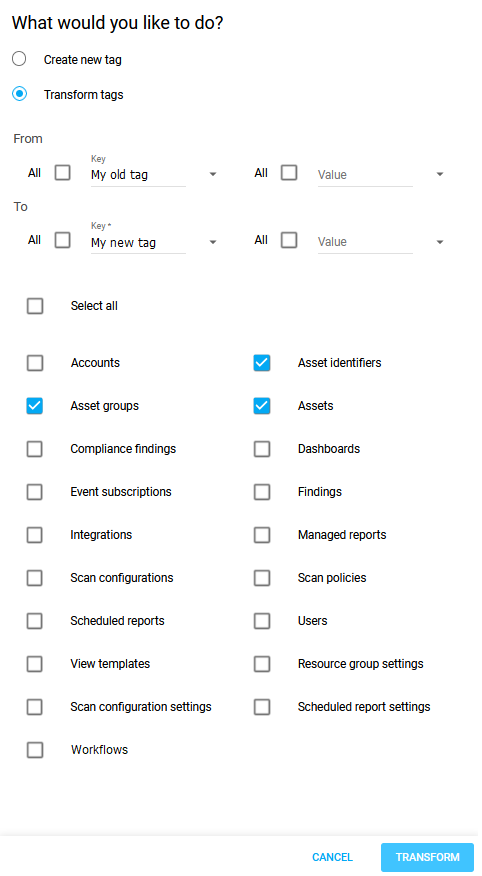
Enter a From Key name or select one from the drop-down menu.
Enter a To Key name or select one from the drop-down menu.
You can select "all" for Key or/and Value instead of a specific key/value.
Example, you have 2 tags
Tag1, Key = Loc, Value = Sweden
Tag2, Key = Loc, Value = Denmark
To transform select
From: Key = Loc, Value = All
To: Key = Location, Value = All
This transforms both the tags above and change the key from Loc to Location
Transform:
From: Key = Loc, Value = All
To: Key = Location, Value = Nordic
This merges the two tags above to one with Key = Location, Value = Nordic
Click the blue Transform button to complete the change.
Removing a Tag From the Tag Manager
To delete a tag in the tag manager:
Open Tags from the Main Menu.

Right-click the tag you want to remove and select Delete.
Verify by clicking on the red DELETE button.

Or
Open Tags from the Main Menu.
Select the tag from list by checking the box.
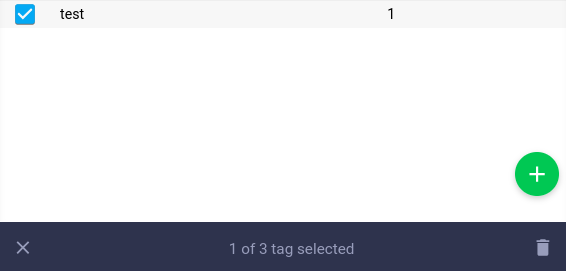
Click on the Bin icon in the toolbar in the lower right corner.
To confirm deletion, click the red DELETE button.

Related Articles
Copyright
© 2025 Outpost24® All rights reserved. This document may only be redistributed unedited and unaltered. This document may be cited and referenced only if clearly crediting Outpost24® and this document as the source. Any other reproduction and redistribution in print or electronically is strictly prohibited without explicit permission.
Trademark
Outpost24® and OUTSCAN™ are trademarks of Outpost24® and its affiliated companies. All other brand names, product names or trademarks belong to their respective owners.
